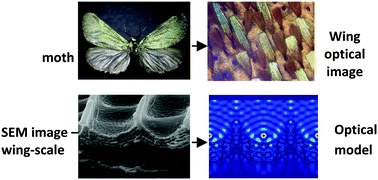Synergy of interference, scattering and pigmentation for structural coloration of Jordanita globulariae moth
Abstract
Structural and pigment colorations are omnipresent in insects, producing a range of colors for camouflage, warning, mimicry and other strategies necessary for survival. Structural coloration has attracted a lot of attention due to its significance in biophotonics, biomimetics and even esthetic appeal. The coupling of structural and pigment colorations has been largely unnoticed. Herein we show how pigments, scattering and interference work together in two-dimensional waveguiding structures to produce the coloration of Jordanita globulariae (Huebner, 1793), a moth whose forewings sparkle with slightly iridescent green scales. We show that subwavelength structures scatter and couple light into a concave multilayered structure to enhance the absorption of pigments. A finite element method (FEM) model, adequately describing the photonic properties of J. globulariae, was developed based on the nanoscale architecture of the insect's wing scales. The principle of absorption enhanced by scattering and waveguiding is present in many insect species and might be imitated to tailor the spectral properties of optical devices.



 Please wait while we load your content...
Please wait while we load your content...